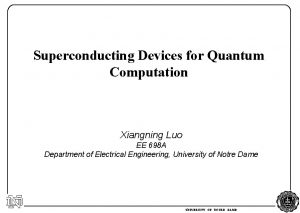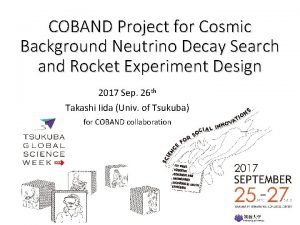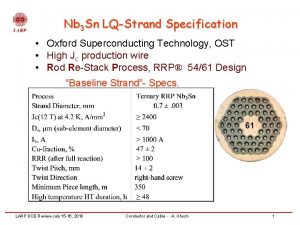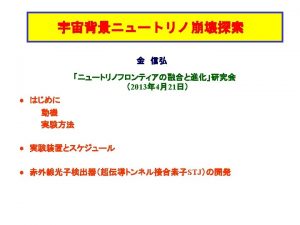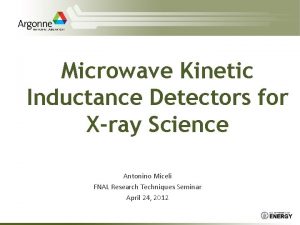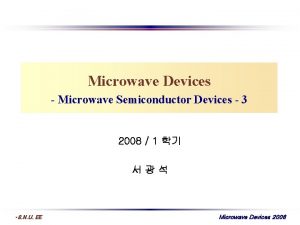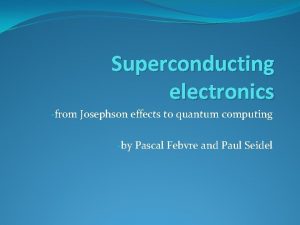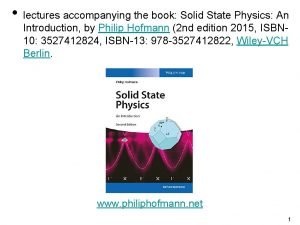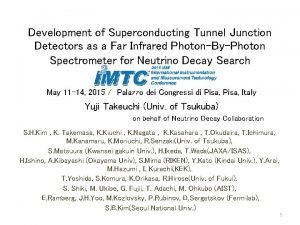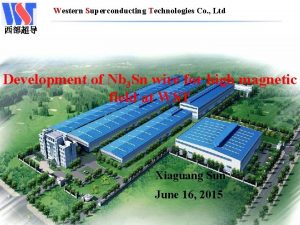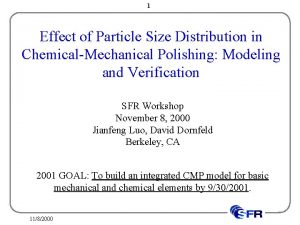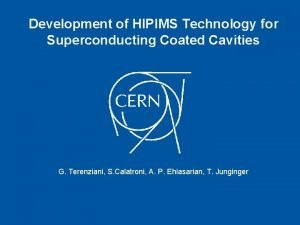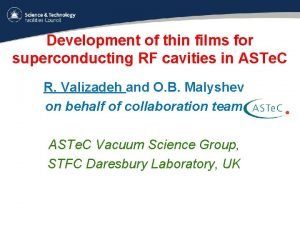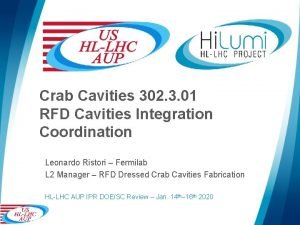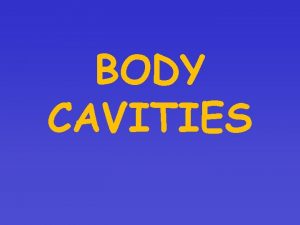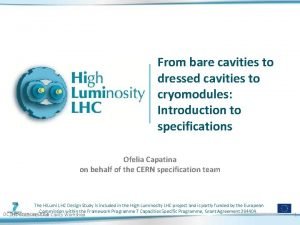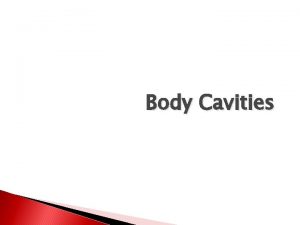Development of ChemicalMechanical Polishing for Superconducting Cavities Shekhar










- Slides: 10

Development of Chemical-Mechanical Polishing for Superconducting Cavities Shekhar Mishra, Fermilab Mark J. Oreglia, Univ. of Chicago Cliff Spiro, Cabot Microelectronics

Project Summary • High Gradient (~35 MV/m) and high yield of the SRF cavities are needed for – International Linear Collider (ILC) and High Intensity Proton Accelerator (Project -X). • State of the art cavity manufacturing and processing : – Electo-polishing and High Pressure Rinse • Remove the damaged Niobium layer – Average Gradient is 20% lower – Yield is less than 25% • Limitation: – Complicated procedure, dangerous chemical, expensive – Niobium surface contamination and/or surface imperfection caused by either manufacturing or processing (Sulfur contamination) • Proposal: – Chemical-Mechanical Planarization technology to remove the damaged Niobium layer 11/5/2020 ANL-FNAL-Uof. C Collaboration Meeting 2

9 -cell Test Results ILC Goal Average A 6 -8, AES 2, 4 = 32 MV/m 11/5/2020 ANL-FNAL-Uof. C Collaboration Meeting A 9 reprocess at Jlab 3

Why alternate technique ? • The electrolyte is a mixture of hydrofluoric and sulfuric acid. Details not fully understood. • Manufacturing or acid related defect: ~600µm beads on Nb cavity • Acid related contamination • Sulfur Deposit • Surface Smoothness: RMS: • 1247 nm fine grain BCP • 27 nm single crystal BCP z θ 1 mm 11/5/2020 • 251 nm fine grain ep These two problems will require mechanical polishing that can make a smooth surface. ANL-FNAL-Uof. C Collaboration Meeting 4

5 Introduction to Cabot Microlectronics and Chemical Mechanical Planarization (CMP) • Leader in CMP slurries – – Pioneer in CMP technology Copper, Tungsten, Dielectric, Data Storage CMP pad offering in early stage commercialization ESF consumable and service offering in non-semiconductor applications • Unparalleled track record • Outstanding technology and manufacturing infrastructure • World-class team of scientists and technologists – Deliver tens of millions of gallons to customers globally – Robust ramp of new products to high volume production – Provide global support and service Non-planarized IC product Planarized IC product © 2005 Cabot Microelectronics Corporation Confidential

6 CMP of Nb 20 X Field of View (approx. 230 um x 300 um) BEFORE Rq = 603 nm Heavily cratered surface from machining AFTER Rq = 3. 5 nm Small islands appear to be grains. Highest point to lowest point around © 2005 Cabot Microelectronics Corporation 18. 6 nm. Confidential

Fermilab Tumbling Machine Not installed. Design and Engineering needed to hold the cavity in place and liquid flow etc. 11/5/2020 ANL-FNAL-Uof. C Collaboration Meeting 7

New Vertical Test @ FNAL Nine-cell Tesla-style cavity • Recently commissioned (IB 1) – – Existing 125 W@ 1. 8 K Cryogenic plant RF system in collaboration with Jlab Capable of testing ~50 Cavities/yr Evolutionary upgrades: • Thermometry for 9 -cells, 2 cavities at a time, 2 top plates, Cryo upgrades • Plan for two additional VTS cryostats – Ultimate capacity ~ 264 cavity tests/yr Plan for 2 more VTS pits VTS Cryostat: IB 1 New RF & Control Room 11/5/2020 ANL-FNAL-Uof. C Collaboration Meeting 8

Plans and Possibilities • Development of the chemical that would be used in the Chemical Mechanical Polishing (CMP) of Niobium – Small sample test • Accelerating Gradient Test: – Polish 1 -cell (1. 3 GHz) Nb cavity using the Fermilab Tumbling machine – Rinse with high purity water – RF test in the Fermilab Vertical Test Facility • Possible Advantage • • • Small size R&D project with great potential • 11/5/2020 No dangerous chemical A much simplified procedure that could lead to considerable cost saving Could potentially reduce acid related defects and contamination Could eliminate surface defects produced during manufacturing Excellent training opportunities for students in Accelerator R&D ANL-FNAL-Uof. C Collaboration Meeting 9

Budget %FTE Uof. C Fermilab -Undergraduate Student Assistant 100% $12, 500 -Engineers 5% $6, 500 -Technician Graduate Student Tution 20% $26, 000 Cabot Salary and Fringe Benefits - Post-doctoral -Graduate Student Assistant Material and Supplies $1, 000 Publication Cost (Conference) $1, 500 Total Direct Cost $15, 000 $17, 500 $35, 000 $50, 000 $35, 000 • Build on Surface science Research • Student training in Accelerator R&D (Fermilab Accelerator Ph. d Program) • Local Industry involvement • Leverage existing laboratory infrastructure 11/5/2020 ANL-FNAL-Uof. C Collaboration Meeting 10
